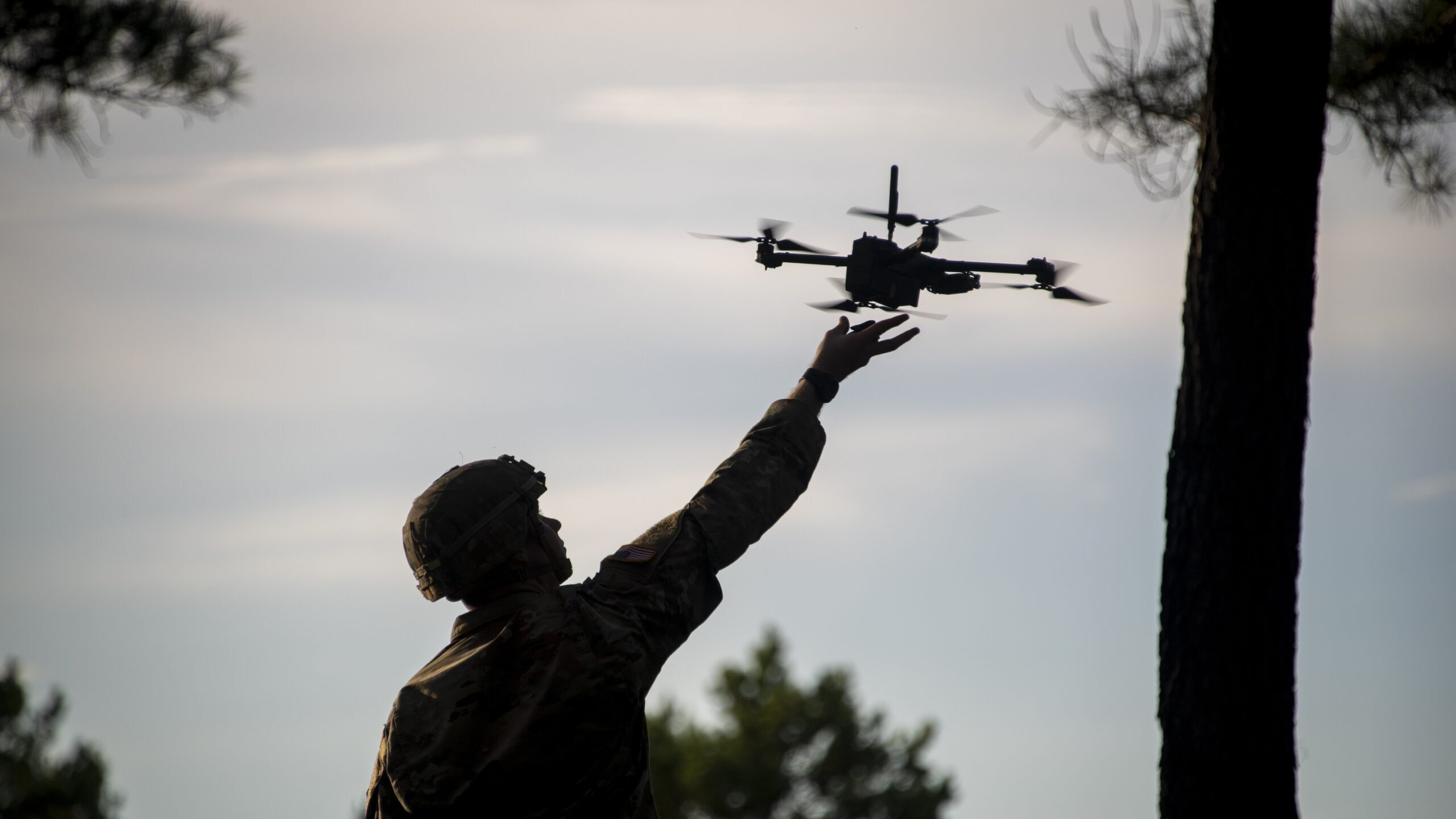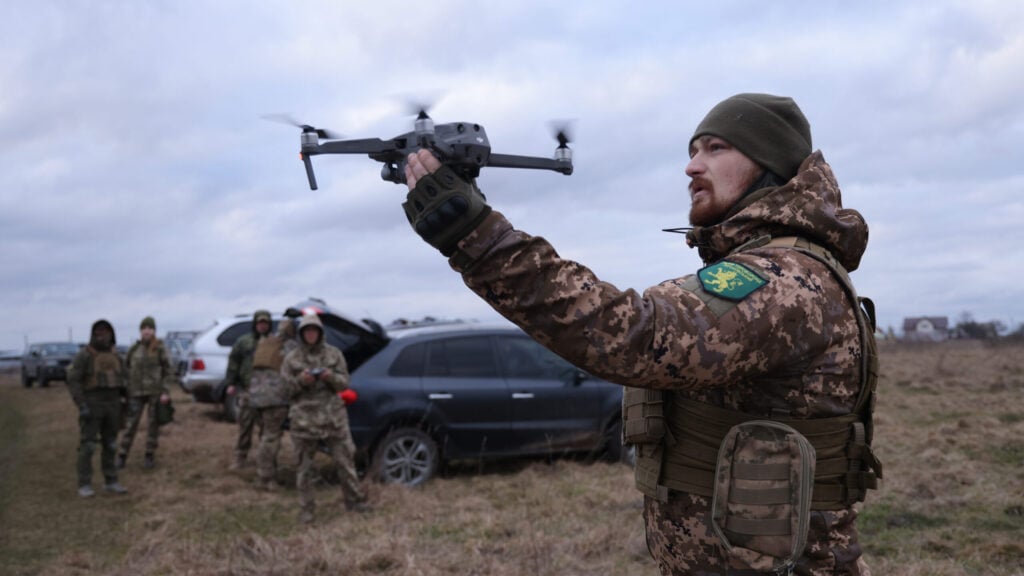WASHINGTON — Ukraine is on the march with a motley mix of weapons, from 70-ton Leopard II tanks to two-pound mini-drones. And while the war has been a brutal proving ground for a wide range of technology and tactics, arguably nothing has defined the Ukrainian conflict more than the ubiquity of drones.
Cheap flying robots, like the Chinese DJI Mavic, with even high-end models costing just a couple thousand dollars, can pinpoint targets for artillery, alert troops to lurking ambushes, drop improvised bombs like a flying IED, and even capture video for online propaganda.
These drones are too small, slow, and low for jet fighters or anti-aircraft missiles to take out, but Ukraine is still losing an estimated 5-10,000 a month — over 160 every day. While gunfire from the ground accounts for some, they’re going down in droves to electronic warfare (EW), which can scramble their GPS navigation systems or jam the radio-control links to their distant operators. Without constant human guidance, the drones’ tiny computer brains may crash them into trees, or just hover safely in mid-air, awaiting new commands, until the batteries run out and they fall to the ground.
In place like Bakhmut, which saw some of the fiercest fighting of the war, Russian jamming became so intense that DJI Mavics and similar off-the-shelf drones could only venture a few hundred yards from their operators without losing the link. “In December, we were able to fly three kilometers [1.8 miles],” a Ukrainian drone operator told the Guardian in April. “Now the guys are saying they cannot fly further than 500 meters.”
It might seem that the logical next step in this mini-drone arms race is to harden the drones against electronic warfare attacks — but several experts told Breaking Defense it’s probably not worth it. Instead, the answer is just to buy and fly more.
Once again, in war quantity has a quality all its own. In particular, as an asset gets cheaper and more numerous, you can use it for more and riskier missions, because losing one, or thousands, doesn’t hurt the way losing a more expensive system does.
“You can use them in more aggressive ways because you don’t care if they get lost,” said Zachary Kallenborn, a policy fellow at George Mason University. And, he laid out in an interview, it’s a great return on investment to sacrifice a couple thousand dollars’ worth of drone to save a soldier from walking into an ambush, or even to avoid firing a few dumb artillery shells — worth a couple thousand bucks apiece — at the wrong target.
In Ukraine today, “commercial quadcopter and FPV [First Person View] drones are treated as expendable munitions,” said Samuel Bendett of CNA in an interview with Breaking Defense. “Both sides recognize that the adversary EW is having a massive effect on such drones, but it’s not cost-effective to proof them against EW. It’s just cheaper and easier to get large quantities of COTS [Commercial Off-The-Shelf] UAVs and replace lost drones.”
That’s a lesson the US military has struggled to learn, with its long and unhappy history of “gold-plated” acquisition programs that pile on esoteric but well-intentioned technical requirements until cost, weight, and development time spiral out of control.
‘It’s Got To Be Expendable’
“In this desire for an exquisite capability, we are losing out on the requirement to get these systems into the hands of soldiers at every echelon,” said Patrick Donahoe, who recently retired from the US Army as a two-star general. “It’s got to be expendable, [so] if the link gets broken and it crashes, we don’t have to go look for it.”
“As a young captain in Bosnia, I spent… a day and a half tracking units looking for what became of a Predator,” he told Breaking Defense. “In Iraq, as a battalion commander, I spent two days with guys out looking for a Raven that crashed in the Euphrates river. Why are we doing that?”
Recently, however, even the US Army showed signs of coming round. In May, it released a Broad Agency Announcement [PDF] that asks small businesses to submit proposals by June 27 for dropping bombs from mini-drones. Emphasizing simplicity, the Army mandates use of munitions already in its supply system, asks that they be at least as lethal as a grenade-dropping drone already in development in-house at DEVCOM’s Armaments Center, and says they should be safely attachable (and detachable!) “by soldiers in the field.”
Most importantly, the service requires companies to use drones already approved by the Defense Innovation Unit (DIU) “blue list.” Those are all relatively small and, by US Army standards, inexpensive commercial options, such as the Skydio X2D, starting at about $10,000 retail, about the cost of five Chinese Mavic Pros. The X2D is already in use, though unarmed, by Army platoons as part of the RQ-28A Short-Range Reconnaissance system.

A soldier tests a candidate for the Army’s Short-Range Reconnaissance (SRR) drone in 2020 (photo by Mr. Tad Browning, US Army Operational Test Command)
In fact, many experts and even some Ukrainian combat vets argue that military Medium-Altitude, Long-Endurance (MALE) drones like the famous Predator or the Turkish-built Bayraktar TB2 are just too big and fly too high, making them easy prey for radar-guided anti-aircraft weapons that cannot spot the smaller, lower-flying quadcopters. “Knowing the Russian air defense right now… I’ll give you a 90 percent chance that it will be shot down,” one Ukrainian Air Force officer said last year about the US Army variant of the Predator, the Gray Eagle. “Bayraktar is much cheaper, so it’s okay to lose Bayraktars.”
But even the cheapest model of Bayraktar costs at least $1 million, less than a Predator/Gray Eagle, but about as much as a hundred Skydio X2Ds or 500 Mavic Pros. Of course, these drones have radically different capabilities, with the big MALEs having much longer range and larger payloads. The purpose-built military drones also tend to have some built-in protection against electronic warfare, such as jamming-resistant antennas, alternatives navigation systems for when GPS goes down, or even autonomy software that can fly them without human oversight.
Adding such EW defenses to a much smaller mini-drone, however, runs quickly into limits on weight, power consumption, and cost.
“A DJI drone [is] meant for taking photographs of your pool or filming snowboarders going down the slopes; that’s not meant for fighting sophisticated electronic warfare, [and] at least some of the traditional approaches that you use to overcome jamming, electronic warfare, aren’t going to work very well with these small drones,” said Kallenborn. Better antennas weigh more and take more space, which quadcopters cannot spare; stronger transmitters need more power and drain a quadcopter’s battery faster, reducing already limited flight time.
AI For Drones?
Future advances could let you cram more capability onto a small, cheap platform — especially when it comes to computing power and artificial intelligence. In theory, an AI drone could fly without a live link to a human operator: It could get its instructions before launch, fly itself around the designated area, use object-recognition software to recognize potential targets, and send back brief, compressed and encrypted reports instead of live video.
Even some of today’s DJI drones can already track a designated target, Kallenborn said. But high-end AI currently runs on big, powerful computers — server farms so expensive that ChatGPT loses money with every answer — and wouldn’t fit into a quadcopter-sized digital brain. “Any sophisticated automated intelligence processing would require significant compute that wouldn’t be available on a small drone,” he said, “Autonomy and AI absolutely can help, but given the limits of that capability at the moment, it’s not a silver bullet.”
“AI is unlikely to impact the EW offense vs. drone defense balance in the short term, [and] anything beyond the short term is difficult to speculate on,” agreed Kyle Miller, research analyst at Georgetown University’s Center for Security & Emerging Technologies. “Firstly, the AI, particularly computer vision, models are not at a level of performance… to operate without a constant link to an operator. Secondly, most COTS drones used in Ukraine don’t have enough onboard processing power to effectively run state-of-the-art computer vision models in the first place.”
In fact, while an AI drone would be more resilient against jamming of its control links, it would be just as vulnerable to EW that blinded its sensors — and arguably more vulnerable to hacking, since it would be controlled entirely by complex software. “You would be much more resistant to some types of EW — jamming of [your] datalink — but not necessarily to others,” said Mauro Gilli, a senior research at the Center for Security Studies in Zurich. “As to EW-delivered malicious software… an autonomous system could be more vulnerable than a remotely-controlled one.”
“Definitely, COTS drones are particularly vulnerable to electronic warfare, but any platform that relies on the electromagnetic spectrum for its operation is by definition vulnerable to EW,” Gilli told Breaking Defense. “Effective counter EW is technologically demanding and hence expensive, so it is really a big question as to whether it makes economic sense to make a cheap platform less vulnerable… My sense is that for most COTS drones, the cost is not worth the benefit.”























